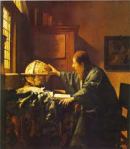 This work is about ‘The Geographer’ which is one of the approximately 34 paintings, we know, created by Johannes Vermeer. This painting was finished in 1668-1669. Hence, this painting belongs to the golden age of Dutch painting. ‘The Geographer’ was exposed in Städelsches Kunstinstitut, Frankfurt am Main. In addition, this painting was also exposed in the Guggenheim museum of Bilbao some months ago. (You can see a video about it in the Resources esxposed below).
This work is about ‘The Geographer’ which is one of the approximately 34 paintings, we know, created by Johannes Vermeer. This painting was finished in 1668-1669. Hence, this painting belongs to the golden age of Dutch painting. ‘The Geographer’ was exposed in Städelsches Kunstinstitut, Frankfurt am Main. In addition, this painting was also exposed in the Guggenheim museum of Bilbao some months ago. (You can see a video about it in the Resources esxposed below).
I chose this painting because it is different from others. Most of Vermeer’s paintings represent women in a room. However, this painting is one of the few paintings in which a man is represented in a room. Women are usually looking through the window and in this case it is a man who does it. At those times, the role of men was very different from the role of women. In addition, the activities they made were also very different. Men were the ones that travelled around the world while their wives, daughters and so on were at home.
About the painting itself, there are some important elements to highlight. The first one is the geographer itself, his position and the reflexion of light upon him is very well done. The position of the geographer shows as if he was in balance, thinking of something but an instant later, he continued with his work. It has been said throughout time that the person who appears in the painting could be Vermeer but also some other people has said the man in the painting was Vermeer’s son. However, nobody knows it.
The geographer was dressed in a Japanese-style robe which was very popular at those times among scholars. And, as you can see his hair was curly and long. That shows the style at those times. In addition, when we look at this figure, we can guess he is thinking of something or someone. In the story written for Claire, I have supposed that he was imaging new lands he could discover in his next travels.
 Apart form the geographer, the globe and the signature of Vermeer are also important elements in the painting. This painting is one of the three paintings that contain Vermeer’s signature. The other two are ‘The Astronomer’ and ‘The Procuress’.
Apart form the geographer, the globe and the signature of Vermeer are also important elements in the painting. This painting is one of the three paintings that contain Vermeer’s signature. The other two are ‘The Astronomer’ and ‘The Procuress’.
More important elements that can be seen in this painting are maps which show the art of the person who paint them and also his scientific skills. These maps signify that there is something outside. There is a world to visit. In addition, the compass is a symbol that shows how women are the fixed side and men are the ones who travel around the world to discover it. Finally, the last element I am going to mention is the cloth that is present in some other paintings such as ‘The Astronomer’ and ‘The Concert’.
Most of these mentioned elements are also in ‘The Astronomer’. Both contain the signature of Vermeer although ‘The Geographer’ contain two signatures, one in the cupboard and the other in the top right of the painting. Both paintings contain books, a globe, the same cloth in the same position, a chair, the window in the same side and the cupboard. The left side of the paintings is the most recharged one and the right side contains some shadows that are projected in the walls and symbolize that there is something new to discover.
 In addition, the astronomer has also long curly hair, as the geographer and they are involved in scholarly pursuits. However, there are also some differences, such as, the position of the main figure, the decoration of the window in ‘the Astronomer’ is not present in ‘The Geographer’, the compass used by the geographer was not present in the astronomer but in this last painting there is also another element that is not present in ‘the Geographer’, the planisphere. Apart from the similitude found in the paintings, these works are considered companion pieces because they share the same provenance until 1778.
In addition, the astronomer has also long curly hair, as the geographer and they are involved in scholarly pursuits. However, there are also some differences, such as, the position of the main figure, the decoration of the window in ‘the Astronomer’ is not present in ‘The Geographer’, the compass used by the geographer was not present in the astronomer but in this last painting there is also another element that is not present in ‘the Geographer’, the planisphere. Apart from the similitude found in the paintings, these works are considered companion pieces because they share the same provenance until 1778.
As a conclusion, ‘The Geographer’ has a lot of elements in common with other paintings, even if they were created by other painters since Vermeer was very mock by others. Hence, there are some other paintings created by other important painters that can be compared with ‘The Geographer’. The names of these paintings are the following: ‘Scholar in his study’; ‘Emblem from Abraham Spinneker’; ‘Geographers at work’ and ‘Portrait of Johan van Beverwijck’.
Resources:
- “List of paintings by Johannes Vermeer” Wikipedia Enciclopedia Libre. <http://en.wikipedia.org/wiki/List_of_paintings_by_Johannes_Vermeer>
- “El Guggenheim abre sus salas a los grandes maestros flamencos y holandeses”. Youtube. <http://www.youtube.com/watch?v=6U70uFV8LvI>
- “Web Gallery of Art”. <http://www.wga.hu/frames-e.html?/html/v/vermeer/03d/29geogr.html>
You must be logged in to post a comment.